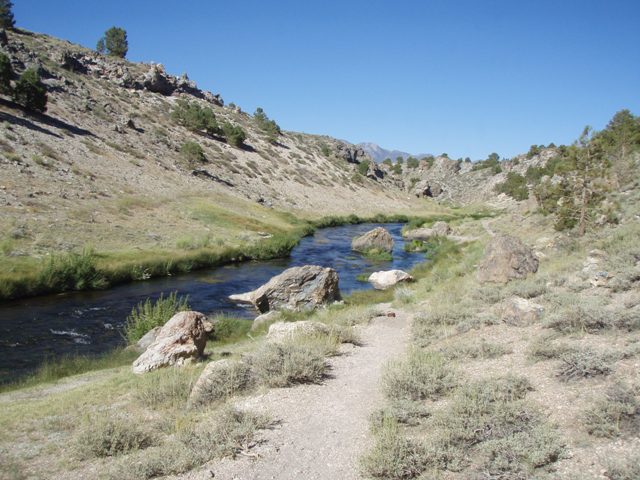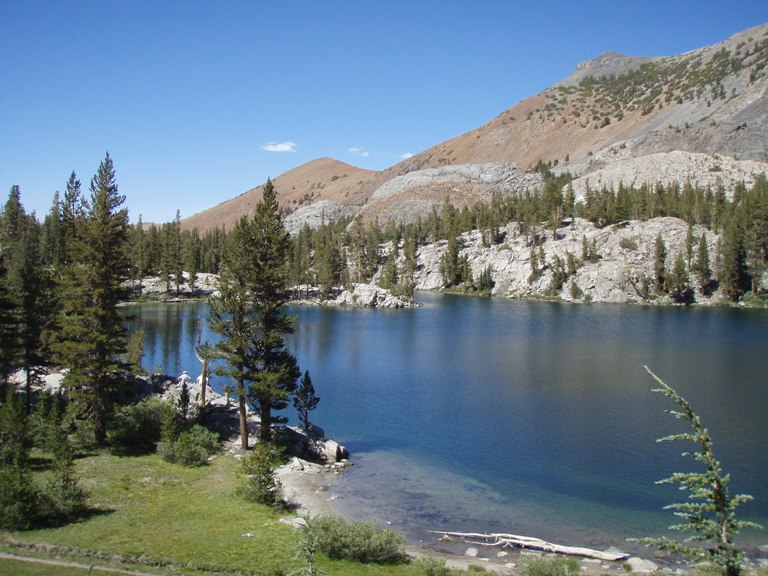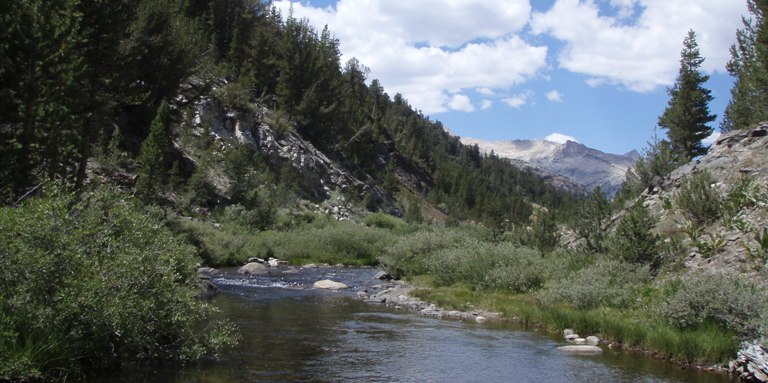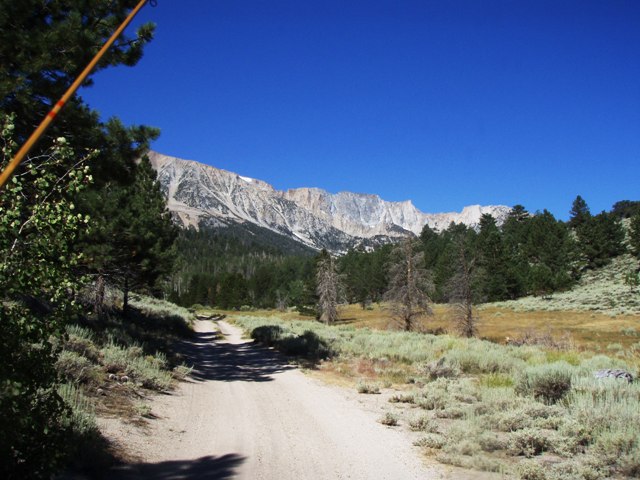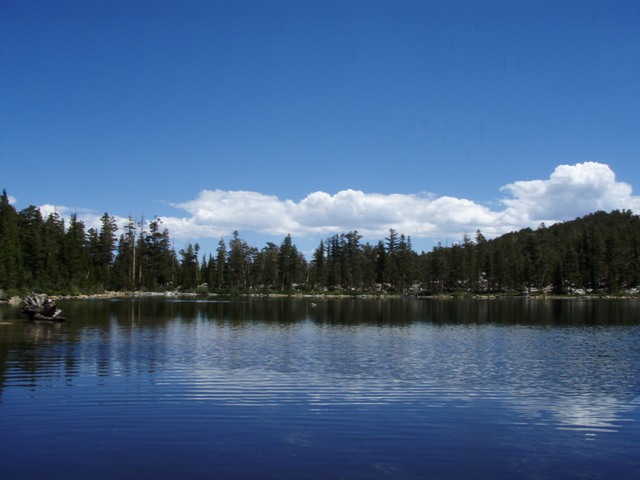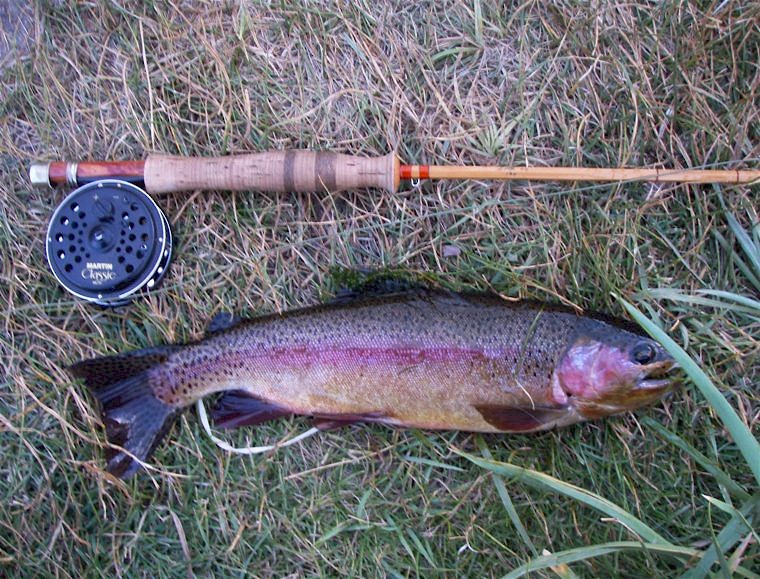|
|
|
|
|
Time:
Wednesday 4:00pm - 7:30pm, Thursday 3:00pm - 8:00 pm, Friday 3:00pm– 7:45pm Narrative: The great thing about the Mammoth Lakes area is that anyone can enjoy the high country. The fit, not so fit, children, the elderly and even the disabled can access high mountain lakes that suit their ability. Last week I cancelled my planned trip to Bear Creek to work two extra days at the office and spend 5 days with Vita in Mammoth Lakes for our 19th anniversary.
It was high country fly fisher.com lite. We rolled into town late Wednesday afternoon and I immediately hit Hot Creek. I decided to fish the lower public section, which I don’t fish too often, maybe every 3rd year or so. I much prefer the middle section but was satisfied with catching several fish that afternoon. Rainbows, Rainbows and Rainbows, Rainbow Trout were all I caught that day. Fishing was a slower than in July but my cdc emerger still worked well. Grey or olive grey micro caddis were coming off and a size 18 fly did better than my usual size 16. I find it hard to leave Vita early in the day when we’re together so my plans for early morning hardcore hikes turned into early afternoon lite hikes. The downside of this is that August is storm month and by 3 or 4 pm thunderstorms often pepper this part of the Sierra. Fortunately, we’re in Mammoth and as I said earlier, this means access for all. Many high country streams and lakes can be reached with very little effort. In fact, one could fulfill a Sierra Grand Slam (Golden, Cutthroat, Rainbow, Brook and Brown Trout) without so much as a 45 min walk from any number of trailheads. Thursday afternoon I made the short hike to Arrowhead and Skelton Lakes. Skelton is supposed to have some healthy brook trout so, based on beta from several sources, I headed straight to its inlet, hoping to take 14 inch brook trout on dry flies. Things didn’t work out that way and I spent a couple hours catching pan sized brook trout on a beadhead ant. These are healthy fish though and not the snaky, stunted brookies you can find elsewhere. Fishing at Skelton started as blindly casting flies into and over the deep water at the inlet. The lake has plenty of vegetation and is sure to hold healthy fish. I met a single success doing this and it’s really not my thing so I quickly switch to finding and targeting specific fish. This worked well. The fish held over the weed beds just off shore and though it was deep, they could still be seen. A good cast, a pause to let the fly sink to the proper level and a few twitches was all it took to entice a strike. Both Skelton and Arrowhead are supposed to hold healthy rainbows as well but I’ve not seen them. These two lakes and the sections of stream in between and above would be a great place to bring some kids for their first fly fishing experience. These sections of stream would be fun for anyone and would make a great small stream adventure. The section below Skelton had some slow meadow water that would be a challenge for even the most advanced small stream fly fisher. Arrowhead often reminds me of Camp Lake in that you can catch brookies all day on dry flies. Unfortunately, I arrived at Arrowhead late in the afternoon and the sun had already set. The water was pitch black and spotting fish was impossible. I worked the bank with fan casts before power walking back to the car in hopes of catching the last hours of light at Hot Creek. I arrived at Hot Creek at 7:45pm and fished it for 15 min. before it became to dark to see my line. In that time I landed two fish- a 4 inch brown which I sent flying over the bank on my set and back into the water with a forward cast and a 15 inch brown. (Insert gaping mouth, big smile emoticon here.) The cdc cripple rules! August 15th Lee Vining Creek, Hot Creek
Time:
Friday ~2:30pm - 7:30pm, Narrative: Friday I got a late start and when I arrived at the trailhead for my destination lake, the storm clouds were already overhead. I fished Lee Vining Creek instead. Lee Vining Creek is a great creek for honing one’s fishing sighting skills. The water is crystal clear and the planter rainbows appear as grey torpedoes below the surface. The wild brookies appear as flaming orange streaks during the spawning season, only the browns are truly tough to see. Fishing was good and for the first time ever, I ran into another person fishing a bamboo rod. I was working my way out of the pocket water section of the canyon to the slicks and undercuts of the meadow when I noticed two people walking downstream. They stopped when they saw me and crossed the stream. The brush was high enough that I couldn’t see them and 5 min later I hear, “Hi, don’t I know you from Oakland?” “Yep”, I replied. “Jim right?” “That’s me.” It was a fellow from the Oakland Casting Club. I’m terrible with names but Dan was kind enough to introduce himself and show me the rod he was fishing. He was a hobbyist rod maker, like me, and was fishing rod number 1- a copy of the Paul Young Perfectionist taper. I should have asked to cast the rod. I’ve heard good things about the Perfectionist but have yet to cast one. Unfortunately, I lost the opportunity. We parted ways and I continued to catch medium sized stocker ‘bows and pan sized browns and brookies. Again in the evening it was back to Hot Creek.
August 16th Andy’s Lake, Hot Creek
Time:
Friday ~11:30pm - 3:00pm at Andy’s Lake and 5:30 to 7:45 at Hot Creek. Narrative: Saturday it was time to do some serious high country fishing. I had planned to fish 3 lakes on this trip, the Cottonwood Lakes area, The Lake Which Shall Not be Named, and a new lake I’ll call “Andy’s Lake”. I was a little down on myself for not fishing the first two but I was definitely not going to make it three for three. Andy’s Lake was close enough that I could leave mid morning and still have 3 or 4 hours to fish before the storms moved in. Many of the lakes I want to fish this year are at the end of jeep trails and unfortunately my Corolla, can only take the roughest of fire trails. I pass on large rocks and sand. The last mile before the trailhead the road ascends a steep, sandy two hundred feet. I had to ditch the car and walk the last mile to the trailhead. After the initial steep grade, the fire road skirts a nice long meadow where I imagine wild horses once roamed. The trail to the lake turns ugly immediate. It’s a steep 800 feet gain in the first half mile and then it’s a somewhat pleasant rolling hike through aspens and Jeffrey pines. The latter half of the climb parallels a stream which might possibly hold golden trout. It would make a nice destination in and of itself. I made a few casts but didn’t have any takes. The lake was at the base of a peak which climbs to over 12,000 feet. Its banks were extremely brushy and but for a small ring of rocks, which I’m sure are probably flooded during run off, one would have a tough time bank fishing this lake. I worked my way clockwise around the lake, looking for cruising fish. Much of the deep water was beyond casting range and the water was warm enough that the fish weren’t working the shallows. Despite the altitude (9,500 feet) this is a very fertile lake. I saw dragon flies, midges and drowned hornets or yellow termites. I slowly walked along the rocks and on the far end of the lake, found some deeper water. I made a few blind casts to this water but this is never very satisfying for me so when I saw a fish rising off a point, out of casting range, I waded out to the end of the point and began casting. I couldn’t entice this fish so I continued around the lake until I came to the inlet. The water had been surprisingly warm until this point but the water coming out of the inlet was almost too cold to bear. If there were fish in this lake, this is where they were going to be. Typically, the inlets and outlets are the best places to fish. The inlet was at the 3 o’clock position on the lake and I knew if I worked counter clockwise and fished it first, I probably would not get to know the rest of the lake. It took some time to explore the other portion of the lake but I’m glad I did. I waded to the far side of the inlet and started casting away. It wasn’t long before I started casting in the direction of a rising fish. It was like fishing a bone fish flat. I was wading in shallow water to about mid calf to knee deep and several fish were working below the inlet, cruising along the edge of the shallow and deep water. Their cruising was erratic and they seemed to be working a double helix along the transition area. They were finicky and spooky but larger golden trout often are. A cast to the fish would send them to cover. Take the cast, wait and twitch approach and the flies were simply ignored. I had to cast the flies into the cruising lane and wait, wait and wait some more for the fish to strike. It was hard to do and often the fish would reject or ignore the fly for no rhyme or reason other than it simply wasn’t right. Surprisingly, my first few strikes came in succession from several different fish. Each felt the prick of my Adams or cdc ant and I spent much of the afternoon trying to find other patterns to interest the fish. Caddis, Griffiths Gnat, Black Gnat, Klinkhammer, you name it; I tried it with no success. Finally, as the storms started to roll in, I garnered a little interest again in my Para Adams. “Just one fish and I’m outta here” I thought to myself. The 13 inch golden swirled when it took the Adams and then proceeded to nearly spool me. It didn't have much girth but was hot none the less. I was taken aback by how strong this fish was and when I got my first glance at it, shortly before spooling run number 4, I figured I must have foul hooked it. The fish seemed too small to be so powerful. I finally reeled it in and could see my fly planted firmly in it jaw. Unfortunately, I was so eager to get a picture; I lost the fish as I fumbled with my camera. Its image will stay with me for some time. It was most the colorful golden trout I’d seen in some time. I quickly composed myself and headed out. Two hours later, I was again fishing Hot Creek- this time with enough time to do it right. I stalked the bank of the middle public section and found a nice fish on the near bank. The fish worked emergers just under the film and each time it did, it’s large back broke the surface. In my first few casts, the fish immediately moved for my caddis emerger. I missed the hook up and worked the fish unsuccessfully for 40 minutes or so before moving on. Once free to tempt other fish, I worked my emerger through the weeds and pocket water and the action came thick and fast, especially in the pocket water section were the fly wouldn’t hang in the weeds. It was just before the pocket water section where I was again recognized. “I recognize you from your picture, you’re Jimmer” I heard from behind me. It was Artin, from the Southwest board. We Southwest board members wear the black diamond trout patch to recognize each other but it was again the cane rod which was noticed first. We talked briefly, me expressing my excitement of possibly hooking a large fish in the pocket water section and he telling me of his plans for the next day.
“You know this because the stay in once place?” he asked. “Not necessarily but where one big fish holds, another is likely to hold in its absence…. and I’ve been here every night for the past 4 days.” I smiled. I try to be as helpful as I can when I’m fishing, especially on Hot Creek, where there seem to be no shortage of “experts” with “secret flies and techniques”. I actually had a fellow say to me once, in reply to my “how’s fishing”, “good if you know what you’re doing…..” I actually didn’t do well that day so I guess I didn’t “know what I was doing” or maybe I was just wearing the wrong cloths. Those guys that “know what they’re doing” always seem to dress right out of the LL Bean or Orvis catalog. Of course “good” is a relative thing. One person’s good might be two fish an hour, or six fish an hour. It might be two eighteen inch fish taken on three casts all day, or four twelve inch fish taken on a hundred casts all day. But, I digress, that’s rant material. Hot Creek has a reputation for elitism and I try to counter that if I can. I had a good day, so why shouldn't others. Back at the parking lot that evening I spoke with a couple of folks new to the creek. They asked about my set up and I shared with them my flies and how they were rigged. When the one fellow said he was having trouble with the wind, I told him how I deal with it. It maybe counterintuitive but I like I fish a very heavy beadhead as weight and another fly which is the actual fishing fly. I throw a tuck cast and let the fly sink to the bottom. Then I let the wind catch my leader and keep my rod tip forward enough so that the wind and the natural resistance of the heavy nymph on the bottom keep the flies moving very slowly. The wind helps the heavy nymph tick bottom and the when the bow in the line straightens or jumps forward, I set the hook. This is the way I’ve fished for the last several years and I find it works very well. Saturday was my last fishing day. Sunday Vita and I took our time returning to the daily grind and as always, we’re better for having spent time in the mountains.
Previous John Muir Wilderness Chronicle Next John Muir Wilderness Chronicle Chronicle Index
|

